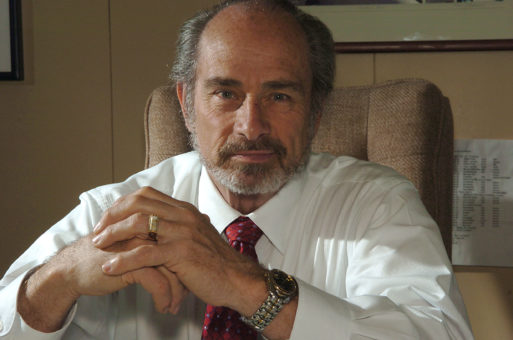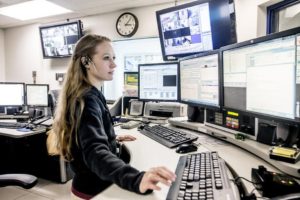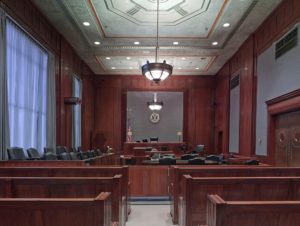Today SevenPonds speaks with Ken Holmes. Originally from Fresno, CA, Ken began working with the Marin County Coroner’s Office as a death investigator in 1975. He worked there for 36 years, eventually serving as the elected coroner for 12 years. A book about his career and the multitude of cases he worked on, “The Education Of A Coroner,” by John Bateson was published this past August.
Editor’s Note: This interview has been edited for length and clarity.
Lucas Morgan: Hello Ken! Thank you so much for taking the time to speak with me. When did you know you wanted to be involved with this kind of work?
Ken Holmes: Pretty much by the time I was in high school I knew I wanted to be in some form of medicine. When I was young, the human body was fascinating to me. How the brain worked, why we could hear, see, smell and all those things.
As I got closer to college, I realized that twelve years of schooling after high school was not fitting into my life plan. My granddad eventually told me that the coroner’s office did all their autopsies at local mortuaries. And the best way to get to know the human body is at an autopsy or in surgery. So I began looking into the funeral industry, and went that route. I got my first job at a mortuary, and then wanted to transition directly into death investigation.

Ken Holmes
Credit: Ken Holmes
Lucas: When was the first time you saw a dead person?
Ken: I saw a dead human for the first time when I was 15. I was with my granddad at a lake in the Sierra Nevada Mountains, and a man who had died sometime earlier was floating on the edges of the lake. We were in a little row boat, and rowed close enough to confirm that it was a human. We then went to find a phone and call the police. Though I wasn’t allowed to get closer than 10 or 15 feet away, I was able to watch the entire process of them bringing him out of the lake.
Lucas: Wow that is quite the story! For those who don’t know, what exactly is a coroner?
Ken: I’m glad you asked that because a lot of people don’t understand it. In the life of a person, there is a birth certificate and a death certificate. The death certificate needs to be certified as to the actual cause of death. If someone is being treated by a physician for something that might end their life and then dies, the physician is required by law to sign the death certificate saying the person died due to the illness they had.
But, there are an awful lot of people who die because of something their physician could never certify. For instance, falling out of a tree, falling off a roof, etc. The law provides that a coroner will look into any sudden or unexpected death. So the coroner’s job serves as an offset to a family physician, if someone should die outside of the presence of a physician. My role was to establish both the cause of death and the manner of death.
Lucas: How long did you work at the Marin County Coroner’s Office?
Ken: Thirty-six-and-a-half years. Nine of those as a death investigator, 14 years in a sort of mid-management role, and the last 12 years as the elected coroner. Coroners were elected to four-year terms. When I retired, however, the board of supervisors combined the coroner’s office with the sheriff’s office. Most counties in California operate this way, where the sheriff also acts as the coroner.
Lucas: How would you learn of a death when you were working? Who would notify you?
Ken: There were two typical routes. First, either a hospital or some sort of institution would call us to say that someone had passed away. And there are criteria for the different agencies to report deaths to the coroner. It doesn’t necessarily mean that there will be an autopsy, but they are required to report the death.
The other most likely way was if a fire department or paramedics were called to the scene of a death. Once they determined there was a death, they would notify our office directly through their dispatch. So, for example, we would hear from the San Rafael Fire Department dispatch or the Novato Police dispatch.

Holmes and his team would sometimes learn of a death from a police dispatch system. Credit: nwherald.com
Lucas: What is the difference, if any, between a coroner and a medical examiner?
Ken: It’s only a political difference. Generally, a medical examiner is a political appointment, whereas a coroner will be elected by the populace. Medical examiners may be required to have some kind of medical training, such as in forensic pathology. Typically there is no such requirement for coroners. The function, however, is the same: to establish the cause and manner of death. And if it’s an unidentified person, they must establish identification and locate and notify next of kin.
Lucas: What was the first case you worked on?
Ken: Well the first case I worked on, I was on duty but was working under my trainer, who was the Assistant Coroner at the time. It was a suicide, but I honestly don’t remember anything about it. The first night on duty by myself, however, I got a call only 12 minutes into my first hour about a rape/murder victim in Novato.
There was a young girl who had been kidnapped a couple of weeks before. Long story short, the perpetrator hid her body in an aluminum storage shed next to his house and covered her with blankets and carpet. He eventually fled to Washington state where he was caught.
Lucas: How many people were on your investigative team at any given time?
Ken: We had seven permanent staff members: The Coroner, the Assistant Coroner, two office staff and three death investigators. In Marin, we had three death investigators from the time I was hired until the day I retired. We never increased our staff, and I was very proud of that.
It would then vary throughout the course of the work we did. For instance, we sometimes hired forensic pathologists, forensic dentists, forensic anthropologists, entomologists, forensic X-ray people, etc. But we would only pay them when we used them.
Lucas: I’m sure it varied greatly, but on average how many cases would come to your office in one day? Throughout one year?
Ken: In Marin County, in the course of a single year, there are about 1,800 total deaths. Of those, around 900 or so would be reported to our office. So that comes out to about three a day, if they are reported to us. Out of that 900, we typically did autopsies, which to us is a full investigation, on about 350 a year. Those full investigations involved all of the background, the medical records, interviewing people, etc. and the autopsy itself.
For a long time, I actually held the record for most cases initiated in one day. We worked 24-hour shifts, by the way. One day during my second or third year, I had 10 separate cases that came in. That record was broken years later, but at the time it was by far the highest number. You know, sometimes you’d have a car accident with like five people, but we would consider that one case. To have ten separate reports in one day was really out of the ordinary.
Lucas Morgan: If a case goes to trial, what role would a coroner play in that court case?
Ken Holmes: We testify fairly often. The coroner’s role in a court case is to be an independent supplier of fact. Say for instance, someone ends up dead. The police arrive and find this person has a hole in their head, and was likely caused by a bullet. The coroner gets called, the autopsy is completed and they find out that it was indeed a bullet that caused that hole.

Coroners act as independent suppliers of fact during court cases
So our role is to describe where the bullet came in, what angle (up or down, left or right, back to front, etc.). and what happened when the bullet went through the body. For example: The bullet hit a little muscle and it passed out through the arm. Well, that didn’t cause the death, but this other one went through the ribs, then the lung and through the heart.
We don’t have any dog in the fight as to who did that. It’s not our job to identify the bad guy. We’re just there to say, “This person died because this bullet did this,” or whatever happened. Our testimony and the information we give have both exonerated and convicted people.
Sometimes it gets more involved. We had a murder a few years ago where a man and his adult son had a physical altercation in which the father died. But since the son lived in the house where it all happened and his fingerprints were all over the place, we had to tie the son physically to the altercation. He had actually bit his father’s ear and bit off a portion of his nose. He also stabbed his father.
So I took castings of the bites on the father’s face, and police took castings of the son’s teeth. The biter left very distinct teeth marks, and with the castings from his mouth displayed on the screen in the courtroom, the jury was able to see that it was quite obvious the son was the culprit. So sometimes we do get involved on that level.
Lucas: Are there any unsolved cases that you think of or that still bother you?
Ken: There are a few. Two come to mind. There was a 91-year-old lady who was found dead in her condo. It looked like somebody broke in thinking they could just rob the place and run. She probably surprised them, and they stabbed her in the neck and left her lying in the hallway right by the front door. They never were able to close that up.
Then just a few years before I retired, another older lady was found dead in her driveway. She was a very cautious woman and stayed to herself. She had an electronic gate across her driveway, and the story was that she never let anybody onto the property if she didn’t know them. I don’t recall at the moment whether she was strangled or stabbed. But they were never able to put together who was responsible. Those are the two stories that stick with me the most.
Lucas: What are some of the more famous cases you’ve worked on? I’m guessing there are a few?
Ken: Yes there are. The first one everybody asks about is Jerry Garcia. But his death was a natural death. He just had a really sick heart because of his lifestyle. So our investigation was pretty minimal. There were the Mitchell brothers, who had the adult entertainment theater in San Francisco. Those two were famous on about 12 different levels. One brother killed the other, and there was this long, drawn-out trial. Essentially the one brother claimed it was in self-defense, even though he had sneaked up to the house in the middle of the night and shot his brother through a closed door. There were also six serial killers that had left bodies in Marin during my tenure, one of which was the Trailside Killer.
Lucas: We’ve touched on this a bit already, but how important are death certificates in the whole scheme of things?
Ken: Well I’ll tell you, nothing happens if there isn’t one. If there is any insurance at all, even if it’s Social Security, the living beneficiary is not going to get it if they don’t have a death certificate.
The way I describe it is that when you are born, you are issued a certificate that says, “You are now officially on this Earth.” And as you go through life, you end up with all kinds of certificates. Sometimes they are called graduations, sometimes certifications, qualifications, etc. All of those become the pages of the book. The cover is the birth certificate, and the last page is your death certificate. It says that what started in the year of your birth has now ended, and this is why. It’s pretty important because without it you can’t be buried or cremated. A crematory or cemetery or whatever entity won’t touch a body unless they have a certification from a doctor or a coroner that gives a reason why you’re dead.
Lucas: How important is compassion in this line of work, particularly when dealing with the family of a person who has died?
Ken: I think it’s very important. I think most people in the industry agree that it is important. But I do know a lot of people in the coroner’s world who do not want to or cannot provide a great deal of compassion. So they come across as uncaring or aloof. And this can have all sorts of psychological rationales. Some just can’t stand to be around people who are crying. My take on that: you’re in the wrong business. Others can only work in this business using what I like to call the “all I want are the facts, ma’am” method. You know, they will come to the door and say, “I’m sorry for your loss, here’s my card.” And many times people will act this way because they are personally uncomfortable with the situation.
My point is that people who go into law enforcement and people who go into death investigation generally handle these situations differently. People who go into law enforcement do so because they want to make a difference; they want to catch bad guys, etc. But they never think that they will have to knock on someone’s door and ruin their life. But people who go into death investigation know that is part of it, and bring with them a certain level of compassion that makes them more adept at using compassion when they go to make a notification.
That is a big reason why I think it’s a shame when counties choose to combine the two offices of sheriff and coroner. A lot of people from law enforcement who are thrust into the role of coroner are uncomfortable with making these notifications and don’t like doing it. So the families of the person who has died can suffer from that.
Lucas: As it is the holiday season, I was wondering if you ever had to work with families of people who had died over the holidays?
Ken: Death plays no favorites. I’ve had four people die in a car crash on Thanksgiving Day, two different families involved. I’ve had suicides on Christmas morning and drunks that fall down and crack their head at Christmas Eve dinner. People die on every single occasion — Fourth of July, Easter Sunday.
It’s very tough on the family in these cases because it marks that holiday forever. Particularly if it’s a suicide on one of those days. Families have more of a problem with someone taking their own life on a holiday than getting run over by a train, falling out of an airplane…you get the picture. But if the person takes their own life, the family feels that there is some sort of message there.
Lucas: How was it for you on those occasions?
Ken: It was definitely harder for us than usual because we know we are messing up their holiday. I’ve had to do notifications on Christmas morning. People were inside opening packages, having eggnog, and then here comes this somber-faced jerk at the front door with a cop on his elbow here to trash their holiday. It’s tough on us. But, it has to be done, and it’s not fair if we don’t do it. I’ve had that question before, “Why don’t you wait until tomorrow?” Are you kidding me? If it was my wife and you waited until tomorrow, I’d have your head! But of course, there are no good days.
Lucas: Have you kept in touch with any families you worked with over the years?
Ken: Oh yes, there are many families that are friends of mine now. Not friends in the sense that we go have lunch and dinner very often, but we send Christmas cards and birthday cards. I would say in some form I am in touch with 20 or 30 families that I have dealt with over the years.
Lucas: Well Ken it was such a pleasure chatting with you! I’ve certainly learned a lot about coroners and the work that goes into this misunderstood profession. Thank you so much for taking the time to talk with me!
Ken: Thank you Lucas!

 What Is A Coroner And What Does Their Work Entail?
What Is A Coroner And What Does Their Work Entail?


 Recovering Cremation Remains After the Los Angeles Fires
Recovering Cremation Remains After the Los Angeles Fires
 “As Tears Go By” by Marianne Faithfull
“As Tears Go By” by Marianne Faithfull
 “The Sea” by John Banville
“The Sea” by John Banville














